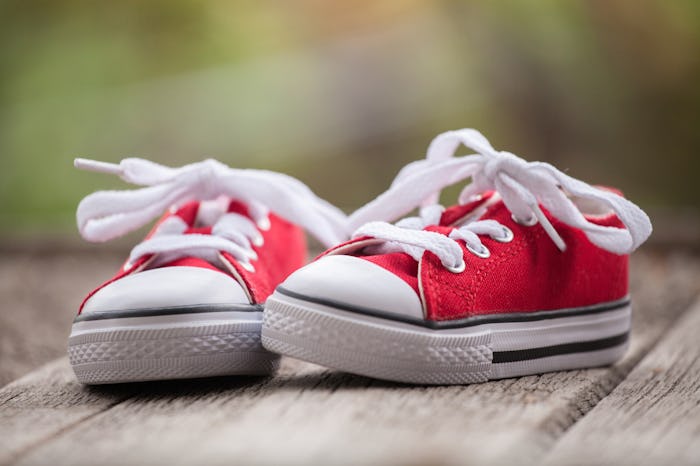Life

Here's Why You Might Want To Hold Off On Squeezing Your Baby's Feet Into Shoes
There's no shortage of wardrobe options for the modern baby. In my opinion, one-piece pajamas are the best option from birth to at least 6 months, but you don't really learn that without firsthand experience. That's why retailers are able to sell everything from flowery headbands to bowties, shoes, and all manner of impractical attire. Chances are you received some of these as baby gifts or bought them yourself. I've been there — it's hard to resist the cuteness. While essentially useless, these accessories aren't controversial — except for footwear. Parents are asking, "Do shoes harm a baby's feet?" While expert opinion varies, there are a few firm guidelines you can use to make healthy footwear choices for your child.
"Doctors today tend to agree that less is more when it comes to shoes in the first few years of life," reported The Chicago Tribune. Therefore, babies who aren't walking yet should be left barefoot or in socks. The experts they interviewed recommend letting children (once they start walking) go barefoot as much as possible and putting them in flexible shoes when bare feet are not an option. To test a shoe's flexibility, see if you can bend it in half. Hand-me-down shoes should be avoided, as kids need to break in a new pair of sneakers to fit their individual feet.
In "Why barefoot is best for children," The Guardian talked to experts who advocate for the benefits of going "unshod" in childhood. According to podiatrist Tracy Byrne, "Walking barefoot... develops the muscles and ligaments of the foot, increases the strength of the foot's arch, improves proprioception (our awareness of where we are in relation to the space around us) and contributes to good posture." When footwear is necessary, Byrne recommends looking for shoes that have "a completely flexible sole, a wide and deep toebox, an anatomically correct last (the 'mould' that a shoe is built on), a closure at the back, and an adjustable closure at the top, such as laces or Velcro."
Even the footwear brand Clarks, which clearly has an incentive to sell more shoes, acknowledges on its website that "Going barefoot is best" during the crawling and cruising stages. But lest you think its impossible to combine retail and advocacy for the benefits of going barefoot, check out Vivobarefoot, a shoe brand that claims to offer as little as possible — just protection from harmful things on the ground. The light and flexible soles, with plenty of toe room, are supposed to mimic the natural condition of a child's foot so they can still feel and grip the ground as they walk, run, and jump.
With so much information available, including an endless selection of baby shoes advertising the latest in scientific benefits, you may end up feeling like you need to spend a lot of money to get the "right" shoes for your child or worry you're causing irreparable damange to their feet. It's comforting to remember that most babies don't like to wear shoes anyway, so even if you bought the "wrong" kind for a family photo session or other special event, your little one probably kicked them off before permanent harm could occur.
When in doubt, turn to the American Academy of Pediatrics, which provides the following guidelines on baby shoes:
"As your child begins to walk outside, she’ll need shoes to protect her feet. They should be comfortable and flexible with nonskid soles to avoid slips and provide room to grow; sneakers are fine. Your child does not need wedges, inserts, high backs, reinforced heels, special arches, and other features designed to shape and support the feet as they have no proven benefit for the average child. Her feet will grow rapidly during these months, and her shoes will have to keep pace. Her first pair of shoes probably will last two to three months, but you should check the fit of her shoes as often as monthly during this formative period. It’s often best to have your infant’s shoes fit by a professional trained in a child’s specific foot needs."
Check out Romper's new video series, Romper's Doula Diaries:
Watch full episodes of Romper's Doula Diaries on Facebook Watch.